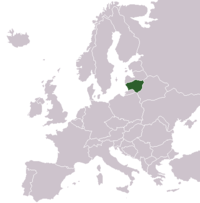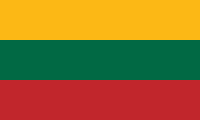Lithuania
Lithuania is a country in north eastern Europe. It shares borders with Poland, Russia, Belarus, and Latvia. The capital city is Vilnius. Other big cities in Lithuania are Kaunas and Klaipėda. Lithuania has been part of the European Union since 2004. Lithuania's currency is the Euro
Lithuania's History
[edit | edit source]

Lithuania was first formed in the 6th century. Lithuania first appeared on the map in the middle of 13th century when Mindaugas united Lithuanian lands. He became a King in 1253 and then Lithuania was recognised as the Kingdom of Lithuania. Later on, the country expanded quickly and in the beginning of the 15th century Lithuanian Duchy was one of the largest countries in Europe, stretching from Baltic to the Black sea. However, due to a great threat of being occupied by Grand Principality of Moscow, Lithuania united with Poland in 1569 into a Polish-Lithuanian Commonwealth country. Lithuania had its own army, currency, laws (the three statutes of Lithuania) and institutions.

Poland-Lithuania — five hundred years ago this was a big empire covering most of modern-day Poland, Lithuania, Latvia, Belarus and Ukraine
In 1795 during the third Partition of the Commonwealth, the country was occupied by Russia, Prussia and Austria. Majority of Lithuanian lands were in the Russian Empire with the rest of it in Prussia. Lithuania re-established its independence after the First World War on February 16, 1918. During the Second World War, The Soviet Union occupied Lithuania in June 1940, one year later Lithuania was occupied by German forces and was reoccupied by Soviet Union in 1944. More than 13% of Lithuanian population, including Lithuanian Jews, were killed during the war, many of them by the secret Soviet police forces were deported to Siberian GULAGs where people died from cold and hunger, the others had been sent to German labour camps.
March 11, 1990 Lithuania was the first Soviet Republic to renew its independence. Lithuania joined the United Nations on September 17, 1991 and on May 31, 2001 it became a member of the World Trade Organization (WTO). On January 4, 1994, it became the first of the Baltic states to apply for NATO membership. On March 29, 2004, it became a NATO member, and on May 1, 2004, Lithuania joined the European Union. Lithuania adopted the Euro as its currency in 2015.


End of the Soviet Union — After 1991 the 15 parts of the Soviet Union became independent countries which today include Lithuania, Latvia, Estonia, Russia and many other countries
Lithuania's Geography
[edit | edit source]Lithuania is situated in northern Europe. It has sandy coastline with big dunes some of which face the open Baltic Sea. There are no mountains in Lithuania, only hills which are not higher that 300 metres (1,000ft). However, there are many lakes and wetlands. The main river is Neman (Nemunas). Green forests cover about 30% of the land. Climate is wet and moderate, though sometimes weather fluctuations happen with -25C in winter and 38C in summer. According to one geographical computation method, Lithuania's capital, Vilnius, lies only a few kilometres south of the geographical centre of Europe.
Lithuania's People
[edit | edit source]There are only 3.3662 million people living in Lithuania, 84.6% of whom are ethnic Lithuanians who speak the Lithuanian language, the official language of the country. Together with Latvian, it is one of the two surviving members of the Baltic language group and one of the oldest used spoken languages in the entire world. There are also some minorities in Lithuania, including Poles (6.3%), Russians (5.1%), and Belarusians (1.1%).
Most Lithuanian schools teach English as a first foreign language, but students may also study German, or, in some schools, French. The majority of Lithuanians are Christian Catholics, even though they were very last in Europe to be baptised. It is said that many Lithuanians were following Baltic pagan religion until the middle of 18th century. Many traditions, celebrations and songs come from the pagan times. People then believed in many gods (gods of earth, wind, thunder, water, etc.).
Since 2004 many Lithuanians have moved to other parts of the EU, especially Germany, the UK and Ireland, to work and live.
Lithuania's Sights
[edit | edit source]Today Lithuania is a popular tourist destination. Most tourists come from the neighbouring Baltic countries, Russia, Germany, Poland and the UK. Vilnius, the capital, is a popular city for cultural museums and night-life. There are three UNESCO World Heritage Sites in Lithuania: Kernavė (an archaeological site), Curonian Spit (shared with Russia) and the Old Town of Vilnius. The Hill of Crosses is a notable religious tourist attraction.
| Wikijunior Europe • Intro • EU • Geo • People • Language • Facts • Quiz | edit | ||


